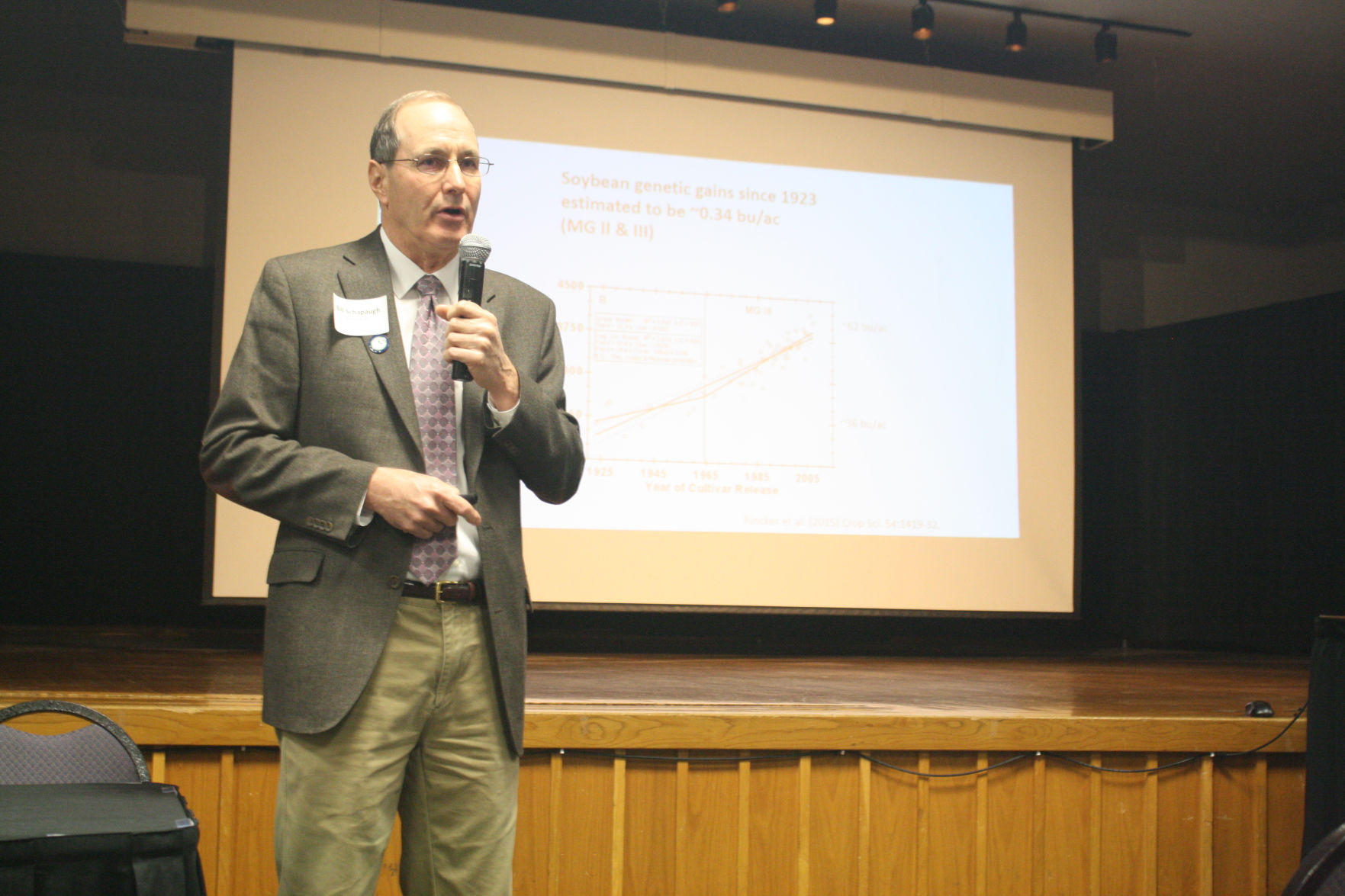New dicamba regulations emerge, 2019 soybean yields trending, where are prices headed?

Dicamba is not new to a soybean farmer, but what may be new are recent regulation updates for the 2019 farming season.
Dallas Peterson, a professor and Extension weed specialist for the Department of Agronomy at Kansas State University, provided new insight for soybean farmers who attended his session on recently at the Capitol Plaza Hotel’s Maner Conference Center in Topeka.
“Dicamba is not a new herbicide, it has been around for over 50 years and it was introduced by Velsicol. For many years we knew it under the trade name Banvel. We are all aware of how dicamba works. It’s very effective at extremely low rates and we know this from experience,” Peterson said.
Dicamba has a long history of causing injury to non-dicamba soybeans. Non-dicamba tolerant soybeans are extremely susceptible to injury at very low rates of the dicamba herbicide.
“Just a sniff of dicamba whether it’s from volatility vapors, physical drift or a little bit of contamination, would cause soybeans to curl or cup,” he added.
In 2017 three dicamba products were introduced to the market: Xtendimax, FeXapan and Engenia.
“These new products are about 70 to 90 percent lower in volatility than older products like Banvel and Clarity,” Peterson added. “However, these new products gave farmers a little bit of a false sense of security that they products were lower in volatility and that they wouldn’t have problems with off-target injury to soybeans.”
In 2018 the Environmental Protection Agency worked together with the companies that marketed the new dicamba products and came up with label changes for the 2018 growing season.
2018 label changes included reclassification as a restricted use pesticide, along with new application and record keeping requirements.
Peterson and his team noticed that in Kansas there was less injury to soybeans in 2018 than in 2017. Unfortunately, other states weren’t as fortunate.
“Increasing our acreage helped 2018 be a better year than 2017. We also communicated to farmers and started raising awareness and implemented training. Illinois had a lot of problems with dicamba along with Missouri and Arkansas,” He added.
New rules for applying dicamba
To keep 2019 a good year for soybean farmers, new rules have been enforced by the EPA for those who wish to apply dicamba to their fields this year.
-
Label changes and requirements for 2019 Xtendimax, FeXapan and Engenia:
-
Only certified applicators may purchase and apply dicamba products.
-
No application under direct supervision.
-
Mandatory dicamba or auxin applicator training required annually.
-
Only apply between 1 hour after sunrise and 2 hours before sunset.
-
Post emergent dicamba treatments must be applied prior to 45 days after soybean planting, or R1 stage, whichever comes first.
-
Recommended to test spray solution for pH and add buffering agent if the pH is less than 5.
-
Do not apply if expected rainfall amount may exceed soil field capacity and result in runoff in the next 24 hours.
-
Enhanced cleanout instructions for entire spray system.
-
Records must be generated within 72 hours of application instead of 14 days.
-
Planting date must also be recorded.
-
In counties where endangered terrestrial dicot species may exist, in addition to the 110 ft. downwind buffer, a 57 foot buffer is required around all other perimeters of the field.
Consult www.epa.gov/endangered-species/bulletins-live-two-view-bulletins for a list of counties requiring additional protection measures along with guidance for specific areas that can be included in the buffer distance calculation for fields in affected counties.
Higher yields
In addition to new products to control resistant weeds, farmers have also been seeing higher yields in their soybean fields.
William Schapaugh, soybean breeding professor at Kansas State University, said soybean yields are going up in the United States.
“There have been a few years here recently where we’re above the trend line for yields, over half a bushel per acre per year increase is due to everything that you (farmers) are doing—new varieties, new herbicides, new cropping systems, new planting rates and more. You are responsible for this increase,” Schapaugh said.
Schapaugh stated in his presentation that the average yield in bushels per acre in soybeans due to genetics is about one-third bushel per acre per year.
Price puzzle
Joe Janzen, assistant professor at the Department of Agricultural Economics at Kansas State University, discussed factors that affected 2018 soybean prices as well as what can be expected in 2019.
One main factor was the trade war with China, which during the months of May and June of 2018 caused soybean prices to decline.
“Stocks, trade, competition with South America and 2019 acres are forming factors that got us to where we are today and will continue to play out over the next year or so,” Janzen said.
With keeping those four factors in mind, Janzen believes U.S. soybeans supply will be plentiful heading into the 2019 marketing year.
“Soybean growers remain optimistic for the 2019. I’m not sure where they’re getting their optimism from, but it’s wonderful,” Janzen added.
Brooke Just can be reached at [email protected].



